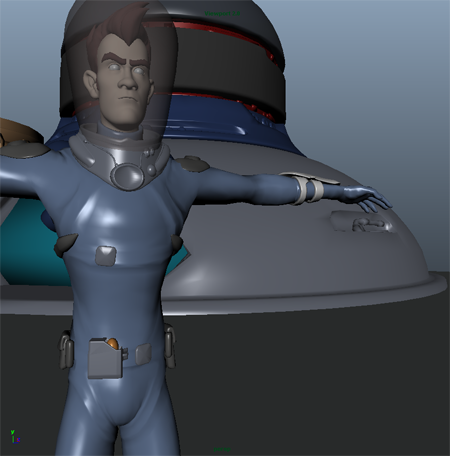
Developed from the Alembic open-source file format, GPU cache files are optimized for fast playback performance in Maya. These performance gains come from the way GPU cache files are evaluated. The GPU cache node routes cached data directly to the system graphics card for processing, bypassing Maya dependency graph evaluation. This data flow alleviates performance issues that arise while opening and playing back large scenes with heavy data sets.
When you import a GPU cache file, it appears in the
Outliner as a single gpuCache node and is represented by this icon: . In the scene, GPU-cached geometry displays as dotted wireframe objects. The
Attribute Editor displays an object-named
Transform node that consolidates all of the individual source object
Transform nodes. An object-named Shape node provides additional attributes, such as
Cache File Name,
Geometry Path and a cache reload button. When changes are made to the GPU cache file after it is first imported into the scene, you can click the
. In the scene, GPU-cached geometry displays as dotted wireframe objects. The
Attribute Editor displays an object-named
Transform node that consolidates all of the individual source object
Transform nodes. An object-named Shape node provides additional attributes, such as
Cache File Name,
Geometry Path and a cache reload button. When changes are made to the GPU cache file after it is first imported into the scene, you can click the
 icon to reload the updated cache file. You do not need to re-import the file using the
GPU Cache > Import
command
icon to reload the updated cache file. You do not need to re-import the file using the
GPU Cache > Import
command
GPU cached objects cannot be edited as Maya geometry.
GPU cache features
With GPU caches you can:
- Use the Snap to points tool to manipulate GPU-cached objects. This includes snapping to the points of other GPU cached polygon objects as well as uncached polygon objects. See Snap one object to another.
- Turn on GPU cache background loading so that cache files load in your scene while you work. See GPU Cache Preferences.
- Export Lambert and Phong shading information from source geometry. See Shade and render GPU caches.
- Cache a number of GPU cache nodes to a single cache file. See Recursive GPU caching.
- Offset the cache to start at a specific frame with the Cache Time Range, similar to an audio file offset.
- Specify preferences that determine the amount of your system's graphics card memory uses to playback GPU cache files. See GPU Cache Preferences.
- Retopologize dense assets with high polygon counts. See Retopologize a GPU cache node.
GPU cache plug-in
To save and load Maya objects and scenes as GPU cache files, load the gpuCache.mll. To load the plug-ins, open the Plug-in Manager ( Windows > Settings/Preferences > Plug-in Manager). See Load or unload Maya plug-ins.
